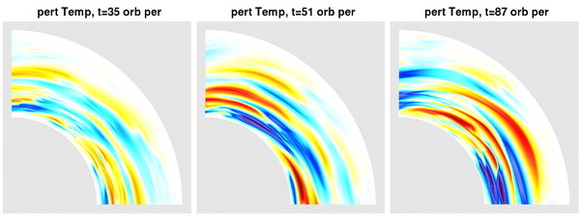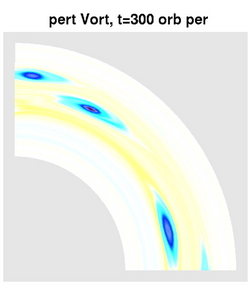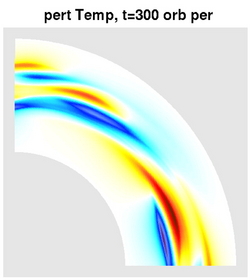
Research: Protoplanetary DisksProtoplanetary disk models are used to study Rossby waves, shear instabilities, and vortex formation in gas disks around young stars that eventually lead to planetary formation. In collaboration with Kieth Julien and Glen Stewart, I studied a reduced, coupled system for vorticity and temperature that was derived from the anelastic equations. Linear analysis of this system shows that the conditions of radiative damping and a radial temperature gradient results in baroclinic instabilities which lead to vortices in the disk. These vortices efficiently concentrate gas and dust and are a potential mechanism for planetary formation. I have created a numerical model of this reduced equation set which is pseudo-spectral (Fourier-Chebyshev basis functions) on a 2D annulus. We use these analytical and numerical tools to study the physical mechanisms that drive vortex formation in protoplanetary disks.


 Perturbation vorticity (top row) and perturbation temperature (bottom row) for a simulation where the radiative cooling time is fast. In this regime, the baroclinic feedback remains strong, and vortices remain strong for the full simulation. 


 Perturbation vorticity and temperature from a protoplanetary disk simulation. Despite dissipation of vorticity from the numerical code, the vortices remain long lived, because baroclinic vorticity production reinforces the vortices and balances the dissipation. Here the "sandwich" pattern about each vortex is clearly seen; temperature perturbations track each vortex with a warm band to the outside and a cool band to the inside. My protoplaneary disk results are described in detail in the following papers: Petersen, M.R., K. Julien, and G.R. Stewart: 2007, Baroclinic Vorticity Production in Protoplanetary Disks; Part I: Vortex Formation, The Astrophysical Journal, 658, 1236 Petersen, M.R., G.R. Stewart, and K. Julien: 2007, Baroclinic Vorticity Production in Protoplanetary Disks; Part II: Vortex Growth and Longevity The Astrophysical Journal, 658, 1252 |

|

|

|